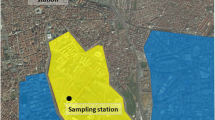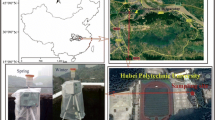Abstract
A field campaign was conducted to measure and analyze 13 polycyclic aromatic hydrocarbons (PAHs) in six major zones in the city of Shanghai, P.R. China from August 2006 to April 2007. Ambient air samples were collected seasonally using passive air samplers, and gas chromatography–mass spectroscopy was used in this field campaign. The results showed that there was a sequence of 13 PAHs at Phen > FA > Pyr > Chr > Fl > An > BaA > BbFA > BghiP > IcdP > BkFA > BaP > DahA and the sum of these PAHs is 36.01 ± 10.85 ng/m3 in gas phase. FL, Phen, FA, Pyr, and Chr were the dominant PAHs in gas phase in the city. They contributed 90% of total PAHs in the gas phase. Proportion of measured PAHs with three, four, five, and six rings to total PAHs was 53%, 42%, 3%, and 2%, respectively. The highest concentration of ΣPAHs (the sum of 13 PAHs) occurred in the wintertime and the lowest was in the summer. This investigation suggested that traffic, wood combustion, and metal scrap burn emissions were dominant sources of the concentrations of PAHs in six city zones compared with coal burning and industry emissions. Further, the traffic emission sources of PAHs in the city were attributed mostly to gasoline-powered vehicles compared with diesel-powered vehicles. It was revealed that the seasonal changes in PAHs in the city depended on different source types. Metal scrap burn was found to be the major source of PAHs during the autumn, while the PAH levels in the atmosphere for winter and spring seasons were mainly influenced by wood and biomass combustion. Comparisons of PAHs among different city zones and with several other cities worldwide were also made and discussed.
Similar content being viewed by others
References
Alves, C., Pio, C., & Duarte, A. (2001). Composition of extractable organic matter of air particles from rural and urban Portuguese areas. Atmospheric Environment, 35, 5485–5496. doi:10.1016/S1352-2310(01)00243-6.
Baidu (2007). Shanghai. http://baike.baidu.com/view/1735.htm.
Bzdusek, P. A., & Christensen, E. R. (2004). Source apportionment of sediment PAHs in Lake Calumet, Chicago: Application of factor analysis with nonnegative constraints. Environmental Science & Technology, 38, 97–103. doi:10.1021/es034842k.
Cheng, J., Yuan, T., Wu, Q., Zhao, W., Xie, H., Ma, Y., et al. (2007). PM10-bound polycyclic aromatic hydrocarbons (PAHs).and cancer risk estimation in the atmosphere surrounding an industrial area of Shanghai, China. Water, Air, and Soil Pollution, 183, 437–446. doi:10.1007/s11270-007-9392-2.
Fang, G.-C., Wu, Y.-S., Fu, P. P.-C., Yang, I.-L., & Chen, M.-H. (2004). Polycyclic aromatic hydrocarbons in the ambient air of suburban and industrial regions of central Taiwan. Chemosphere, 54, 443–452. doi:10.1016/S0045-6535(03)00706-9.
Harner, T., & Bidleman, T. F. (1998). Octanol-air partition coefficient for describing particle/gas partitioning of aromatic compounds in urban air. Environmental Science & Technology, 32, 1494–1502. doi:10.1021/es970890r.
Harner, T., Shoeib, M., Diamond, M., Stern, G., & Rosenberg, B. (2004). Using passive air samplers to assess urban-rural trends for persistent organic pollutants. 1. Polychlorinated biphenyls and organochlorine pesticides. Environmental Science & Technology, 38, 4474–4483. doi:10.1021/es040302r.
Harrison, R. M., Smith, D. J. T., & Luhana, L. (1996). Source apportionment of atmospheric polycyclic aromatic hydrocarbons collected from an urban location in Birmingham, U.K. Environmental Science & Technology, 30, 825–832. doi:10.1021/es950252d.
Guo, H.-L., Lu, C.-G., Yu, Q., & Chen, L.-M. (2004). Pollution characteristics of polycyclic aromatic hydrocarbons on airborne particulate in Shanghai. Journal of Fudan University. Natural Science, 43, 1107–1112.
Jaward, F. M., Farrar, N. J., Harner, T., Sweetman, A. J., & Jones, K. C. (2004). Passive air sampling of PAHs and PCNs across Europe. Environmental Toxicology and Chemistry, 23, 1355–1364. doi:10.1897/03-420.
Kavouras, I. G., Koutrakis, P., Tsapakis, M., Lagoudaki, E., Stephanou, E. G., Von Baer, D., et al. (2001). Source apportionment of urban particulate aliphatic and polynuclear aromatic hydrocarbons (PAHs) using multivariate methods. Environmental Science & Technology, 35, 2288–2294. doi:10.1021/es001540z.
Khalili, N. R., Scheff, P. A., & Holsen, T. M. (1995). PAH source fingerprints for coke ovens, diesel and gasoline engines, highway tunnels, and wood combustion emissions. Atmospheric Environment, 29, 533–542. doi:10.1016/1352-2310(94)00275-P.
Lohmann, R., Northcott, G. L., & Jones, K. C. (2000). Assessing the contribution of diffuse domestic burning as a source of PCDD/Fs, PCBs, and PAHs to the U.K. atmosphere. Environmental Science & Technology, 34, 2892–2899. doi:10.1021/es991183w.
Manoli, E., Kouras, A., & Samara, C. (2004). Profile analysis of ambient and source emitted particle-bound polycyclic aromatic hydrocarbons from three sites in northern Greece. Chemosphere, 56, 867–878. doi:10.1016/j.chemosphere.2004.03.013.
McKenzie, C. H. L., Ayoko, G. A., & Morawska, L. (2005). Characterization of elemental and polycyclic aromatic hydrocarbon compositions of urban air in Brisbane. Atmospheric Environment, 39, 463–476. doi:10.1016/j.atmosenv.2004.09.050.
Menichini, E., Monfredini, F., & Merli, F. (1999). The temporal variability of the profile of carcinogenic polycyclic aromatic hydrocarbons in urban air: A study in a medium traffic area in Rome, 1993–1998. Atmospheric Environment, 33, 3739–3750. doi:10.1016/S1352-2310(99)00114-4.
Parka, S. S., Kima, Y. J., & Kang, C. H. (2002). Atmospheric polycyclic aromatic hydrocarbons in Seoul, Korea. Atmospheric Environment, 36, 2917–2924. doi:10.1016/S1352-2310(02)00206-6.
Poor, N., Tremblay, R., Kay, H., Bhethanabotla, V., Swartz, E., Luther, M., et al. (2004). Atmospheric concentrations and dry deposition rates of polycyclic aromatic hydrocarbons (PAHs) for Tampa Bay, Florida, USA. Atmospheric Environment, 38, 6005–6015. doi:10.1016/j.atmosenv.2004.06.037.
Pozo, K., Harner, T., Shoeib, M., Urrutia, R., Barra, R., Parra, O., et al. (2004). Passive-sampler derived air concentrations of persistent organic pollutants on a North–South transect in Chile. Environmental Science & Technology, 38, 6529–6537. doi:10.1021/es049065i.
Randolph, K., Larsen, I. I. I., & Baker, J. E. (2003). Source apportionment of polycyclic aromatic hydrocarbons in the urban atmosphere: A comparison of three methods. Environmental Science & Technology, 37, 1873–1881. doi:10.1021/es0206184.
Sawicki, E. (1962). Analysis for airborne particulate hydrons, their relative proportion affected by different types of pollution. National Cancer Institute Monograph, 9, 201–208.
Shoeib, M., & Harner, T. (2002). Characterization and comparison of three passive air samplers for persistent organic pollutants. Environmental Science & Technology, 36, 4142–4151. doi:10.1021/es020635t.
Sicre, M. A., Marty, J. C., Saliot, A., Aparicio, X., Grimalt, J., & Albaiges, J. (1967). Aliphatic and aromatic hydrocarbons in different sized aerosols over the Mediterranean Sea: Occurrence and origin. Atmospheric Environment, 21, 2247–2259. doi:10.1016/0004-6981(87)90356-8.
Thorsen, W. A., Cope, W. G., & Shea, D. (2004). Bioavailability of PAHs: Effects of soot carbon and PAH source. Environmental Science & Technology, 38, 2029–2037. doi:10.1021/es0306056.
Wang, J., Zhang, G., Li, X. D., Li, J., Xu, W., Guo, L. L., et al. (2007). Monitoring of polychlorinated biphenyls in the atmosphere of the pearl river delta using PUF-passive air sampler. Environmental Sciences (Tokyo), 28, 478–481.
World Health Organization Lyon (1987). IARC. In overall evaluations of carcinogenicity: An updating of IARC monographs. In: IARC monographs on the evaluation of carcinogenic risks to humans (Vol. s1-42, Suppl7). International Agency for Research on Cancer.
Xiang, L., Gan, Z., Jun, L., Lili, Y., Shihua, Q., Shichun, Z., et al. (2007). Monitoring of polycyclic aromatic hydrocarbons in the atmosphere of china cities using PUF-passive air sampler. Environmental Sciences (Tokyo), 28, 26–31.
Ye, Z., Zhang, G., Zhou, S., Li, J., Qi, S., & Liu, G. (2005). Dry and wet depositions of atmospheric PAHs in the Pearl River Delta Region. Acta Scientiarum Naturalium Universitatis Sunyatseni, 44, 49–52.
Yunker, M. B., Macdonald, R. W., Vingarzan, R., Mitchell, R. H., Goyette, D., & Sylvestre, S. (2002). PAHs in the Fraser River basin: A critical appraisal of PAH ratios as indicators of PAH source and composition. Organic Geochemistry, 33, 489–515. doi:10.1016/S0146-6380(02)00002-5.
Zhang, S. C., Wang, K. Y., Hu, L. W., Shen, Y. T., & Wang, X. Z. (2007a). Concentration characteristics and influencing factors of atmospheric polycyclic aromatic hydrocarbons in TSP in the southeastern suburb of Beijing. China Environmental Science, 28, 460–465.
Zhang, Y.-Q., Sun, Y.-L., Wang, Y., & Tan, P.-G. (2007b). Distribution and correlation analysis of PAHs in the atmospheric aerosol over Qingdao coastal areas. Periodical of Ocean University of China, 37, 475–480.
Zhao, X., Wan, Z., Zhu, H., & Chen, R. (2003). The carcinogenic potential of extractable organic matter from urban airborne particles in Shanghai, China. Mutation Research, 540, 107–117.
Author information
Authors and Affiliations
Corresponding author
Rights and permissions
About this article
Cite this article
Wang, X.Y., Li, Q.B., Luo, Y.M. et al. Characteristics and sources of atmospheric polycyclic aromatic hydrocarbons (PAHs) in Shanghai, China. Environ Monit Assess 165, 295–305 (2010). https://doi.org/10.1007/s10661-009-0946-1
Received:
Accepted:
Published:
Issue Date:
DOI: https://doi.org/10.1007/s10661-009-0946-1




